
| Home | Wye Valley Jcn to Netherhope | Tidenham Tunnel | Tintern Quarry to Tintern | Tintern Station | Brockweir to St Briavels | St Briavels to Redbrook | Wyesham to Monmouth | Signalling | Rolling stock | The Journey |
| Mock-ups |
 |
|
|
This webpage is devoted to our collection of modified photos showing the Wye Valley Railway in a slightly different state to the one that it is currently in - with missing bridges re-instated, platforms re-built and trains sitting on lengths of track long since lifted. They're of varying ages and quality. We reserve the right to not upload our lower-quality attempts. Pictures won't be too big so you can't see the rough edges properly. This system of putting photographs together is generally called digital doctoring and is very popular, particularly for photographs which didn't come out properly, photographs which would look more realistic if modified and photographs which couldn't be taken otherwise. Images were mostly mucked up in Corel PhotoPaint 8, despite it not running properly in WindowsXP (use of the save and load functions occasionally cause it to crash). Re-painting was generally carried out using Gimp 2. Gimp likes to work with curves while Corel prefers straight lines, so cutting and pasting is easier in Corel while shading and painting are easier with Gimp. Corel is also the image re-sizer for the OB for some reason. Adobe software was only used for putting the website together (PageMill 3.0 in case you were wondering). Most of the pictures on this page feature trains in Cornwall. This is because our photography team are hiding there for the duration of the recession. The variety of trains around Truro allows for a variety of trains to make appearances here in modern images. The Bodmin and Wenford Railway, a few miles to the east, has a good collection of locomotives which are entirely suited to being moved to the Wye Valley line, mostly being smaller branch line designs (although none of their locomotives can be positively confirmed as having visited Monmouth). There is also a handy stretch of track as the preserved line enters Bodmin Parkway, junction with the Great Western mainline to Penzance, where side-on views can be obtained of trains without any bits of fencing, boxes of signalling equipment or platforms getting in the way - a rare location and consequently one which features rather extensively herein. Dates reflect when the picture was re-done rather than when it's set. A later date does not necessarily mean a better picture. |
|
Tidenham (2005) 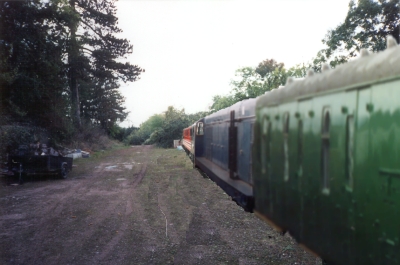
|
A Southern Region Motor Luggage Van, a Class 20 diesel locomotive and a West Coast Class 87 electric sit in the platform of the derelict station with brambles removed from the platform edge. This picture merely assumes that, in the early years of reconstruction by an informal group, various pieces of kit would find their way to the railway when looking for a place to live. A few Class 20s have actually operated on the Wye Valley line, mostly on specials, but the electric-powered MLV and Class 87 are somewhat off the beaten track. |
|
|
|
|
Tidenham (2008) 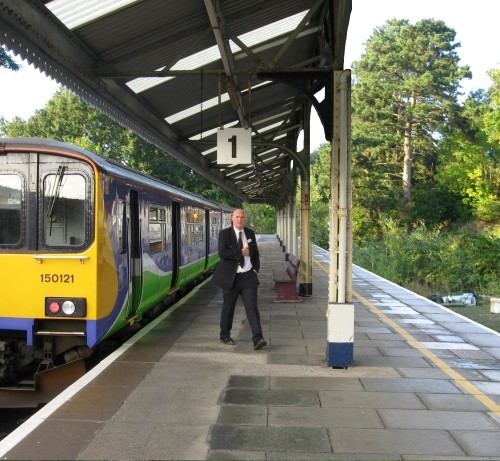
|
A revised image of Tidenham station, from the south looking north, assuming that this is the terminus of the line. The platform is occupied by a terminating British Rail Class 150/1 Sprinter unit which has just run through from Cardiff. The 150/1 fleet was the first of the production build of Sprinter sets and (in contrast to the 150/0 prototypes and most of the units that they replaced) only had two coaches per train, due to Treasury financial constraints. In the event passenger levels rose dramatically when the Sprinters were introduced and the two-car sets proved to be inadequate. After 20 years of running around Birmingham, the North West and London, replacement is starting to be considered and possible new homes for the Birmingham and London fleets are being examined. Two ex-Silverlink Trains sets from London are currently working for First Great Western around South Wales and the West Country and so it would be possible for one of these trains to find itself in the Wye Valley, if it weren't for the lack of suitable railway to run them on. Tidenham is not the station which most people would think of as a possible terminus of the line. However, if Chepstow were to get a hourly shuttle service from Cardiff then Tidenham would provide a suitable turn-back siding where the train would not interfere with mainline traffic. It would also provide access to Tidenham village, be a possible location for a park-and-ride facility (albeit not a very good one, as such services are normally turn-up-and-go) and allow people to reach the National Diving and Activity Centre without using a car. If Sustrans ran a cycleway from here to Tintern it would eliminate the parking problem. This could all be done for the cost of reinstating the junction and clearing half a mile of track. Aside from the business case aspect, the station actually featured here is Truro, with the Falmouth branch train sitting quietly in the platform (hence the large "1" - single platform stations do not normally have platform numbers). The track through platform 2 and the associated roof were removed in the making of this image. In Truro station the buffers are actually behind the camera, rather than at the other end of the train. |
|
|
|
|
Netherhope Halt (2009) 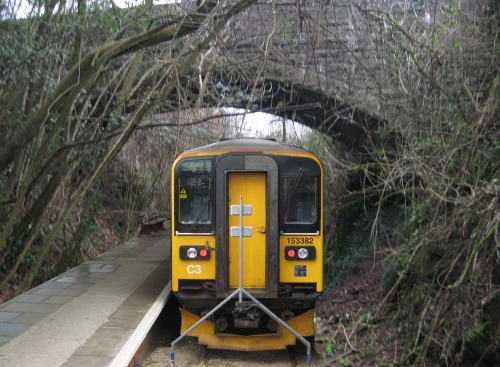
|
Netherhope Halt opened in 1932, closed in 1959 and was demolished in the final years of traffic to Tintern Quarry. Like Tidenham, Netherhope would be a good northern terminus of a line built on the cheap, although Netherhope would require Bishton Bridge to be rebuilt. However, Netherhope is sort of convenient for the north end of Tidenham (indeed, it is rather more convenient for Tidenham than Tidenham station) and takes up all available track south of Tidenham Tunnel. The last passenger train to this spot terminated here in 1980 without heading on through the ensuing 1180 yards of darkness. The platform is platform 1 of Truro station (again). This time it has been cut away from its original location and planted on the other side of the bufferstop. The roof has also been removed properly. The First Great Western Class 153 has just arrived from Falmouth Docks. The bufferstop now has to be protected, in this case by a sand drag and some little red lights on a silly post. The two-car Class 155 Super Sprinter multiple units were built by Leyland in 1988 but did not perform very well, rapidly having to be withdrawn from traffic due to the doors developing a habit of opening while the train was on the move (they were the first time that a production passenger train had automatic doors which were flush with the bodyside rather than inset and sliding into the bodyshell). After one or two reliability improvements it was decided that BR had rather over-ordered on two-car units anyway and 35 of the 42 155s were taken into the workshops and sliced in half to produce 70 single-car Class 153 units for lines where traffic was lighter. Seven were owned by the West Yorkshire Passenger Transport Authority, who declined to have their sets chopped in half and so said sets are the only survivors of Class 155. This picture shows the newer cab; the original cab has a fringe, lower and inset light clusters and a cab which is more than 18 inches deep. BR expressed some pleasure at the time about the fact that the rebuild did not involve moving any external doors, so the later cab was only squeezed in by extending into the vestible area. |
|
|
|
|
Tintern Abbey (2009) %20JPG.jpg)
|
Tintern Tunnel is the second and shorter of the line's two tunnels at 189 yards long, bypassing Tintern as it connected the station with the junction with the freight-only Wireworks Branch. Oddly, it never dawned on the Great Western or its successor, the Western Region of British Railways, to provide a halt at the junction end of the branchline, which was lifted during the Second World War. Nonetheless, any scheme to re-develop the route involves a station of some sort here. Here we see what the tunnel would look like if it was opened out again (currently a 7 foot high unclimable gate blocks the portal) and a platform squeezed in between the tunnel portal and the southern end of the junction. Track, platform and signage are all from the new extension to Penryn station on the Falmouth branch in Cornwall, although the nameboard has been changed to read "Tintern Junction for Tintern Abbey" with an appropriate sketch of the Abbey at the bottom. The speed limits at the end of the platform indicate that most trains are limited to 30 miles per hour through the tunnel, although multiple units can do 50. On the Falmouth branch the differential feels a little odd as all trains are now multiple units, while on the Wye Valley line the maximum speed would probably remain 35 through the tunnel, as it was before the line closed. Just for some general variety (and because we don't have a suitable picture to hand) no train is featured and so you will just have to imagine that you're sitting on the platform waiting for it. |
|
|
|
|
Tintern Riverside (2010) 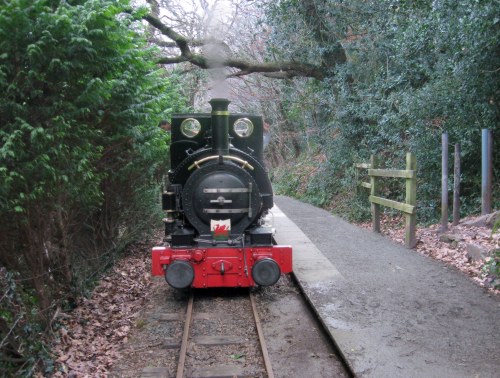
|
The Wireworks Branch makes for some interesting possibilities for a re-opened line; its sharp curvature, limited space and the fact that it provides access to several useful footpaths largely preclude re-opening as a standard-gauge line. Therefore we have put together a picture showing a narrow-gauge (2ft 3in) train - well, strictly speaking, locomotive. A smaller gauge than this would be more useful since it would allow less work to be done on the trackbed and make it easier to set up a shared-use route - either by giving the railway one side of the trackbed or by setting the rails into the path surface. Unfortunately Talyllyn, locomotive No. 1 on the Talyllyn Railway (Mid-Wales), is the smallest piece of kit that we have in our archive of suitable photographs. She was photographed from behind the bufferstops at the railway's western terminus (Nant Gwernol) while she was engaged in running around her train prior to running back down the valley to the coastal town of Tywyn, where the narrow-gauge line terminates close to the standard-gauge Cambrian Coast line. The shield on the front carries a Welsh dragon; consideration was given to replacing it with a Cross of St George but the dragon survived the final cut. Our official re-painter says that this is because the locomotive would still live in Wales in a shed up the Angiddy Valley. (It's actually because he originally got the colours of the Cross of St George the wrong way round and couldn't be bothered reversing them.) Apart from adding the track, locomotive and platform no alterations have been made to the surroundings. Considering that it took about 90 minutes to put together we're quite pleased with the results. |
|
|
|
|
Tintern Central (2010) %20JPG.jpg)
|
The level crossing over the A466 is the centrepiece of this image. In the interests of balance Talyllyn's cousin Dolgoch, locomotive No. 2 of the Talyllyn Railway, gets to star this time, drawing a train over the road. This picture only took an hour to put together and we're not as pleased with it as the last one. This isn't something which would really have been remedied by spending more time on it. Despite a trip to Tintern involving taking a picture specifically to marry up with Dolgoch, the images still refused to match perfectly. The traffic light was extracted from our extensive archive of traffic light pictures and is the best one available. (Actually, it's the only traffic light image that we have. Our photography team are more interested in trains, the occasional road and impressive scenery than traffic lights, and tend to go to much trouble to ensure that none feature in photographs.) In its original location, the traffic light controls traffic emerging from a side road which gives access to some warehouses and Taffs Well station, north of Cardiff. The shadow was added by applying dark grey and black paint to the base picture and making it fairly transparent. The train did come with a perfectly good shadow cast onto the track below it, but most of that was erased as out of place so a new one had to be added. The exhaust is brought over from the original image so the trees which were behind the loco originally may poke threough in places. The shield this time carries the Talyllyn Railway's coat of arms. |
|
|
|
|
Tintern River Bridge (2006, 2008 & 2010)
|
The bridge over the River Wye at Tintern station was mentioned in the 1959 newspaper report on the closure of the line as being in worrying condition and has been attributed as a reason for closure. Once the line was dismantled eight years later the bridge was demolished. As at the time it went from nowhere to nowhere demolition to keep people out of the tunnel was unnecessary (besides, it wasn't walled up until the 1980s). Few pictures seem to have been taken of it before demolition and its absence means that it can no longer be photographed. With this in mind we have arranged a series of pictures showing the bridge as it would look if it were still intact. The upper picture features a suitably cleaned southern abutment with an unsupported girder stretching across the river. The girder sections were taken from an image of the viaduct across the Wye at Lydbrook, on the Ross and Monmouth Railway, with the supports being omitted as the picture is intended to show how the structure would look in its most basic form. At the time we had nothing else available to put the image together with. The smaller of the two viaducts at Lydbrook (the larger one, on the Severn and Wye line, spanned the Lydbrook valley rather than the Wye), the girder structure built by the Ross and Monmouth Railway is retained in as-closed form with walkers being able to cross the bridge on the main structure - at least, when the bridge isn't falling down enough to prompt Gloucestershire County Council to close it. It bears certain similarities to the later bridges at Redbrook and Tintern, except the supports are more flimsy. The northern abutment of the Tintern bridge is out of shot to the left, and probably not quite where the direction of the bridge suggests it should be. The middle picture uses a view from the northern abutment of the bridge and a shot along Penallt viaduct, further up the line, to illustrate how it would look if a footbridge had been slung along the side, possibly connecting the station to Tintern via the riverbank and the Wireworks bridge. As the viaduct at Penallt was also built for the Wye Valley Railway it would be logical for the bridges to be virtually identical, although they were not quite built to the same radius curve - the bridge kindly hides the fact that it is not actually pointing directly at the southern abutment. The bottom picture was inspired by Wye Valley Cycle's ideas, which cleared up some worries by the design team that trains would have to cross a flimsy jungle bridge painted to blend into the background if they were to get past the environmental lobby. The cycleway proposals included a suspension bridge with a 50ft high support post on the northern abutment or a slightly more lightweight bowstring bridge. This bowstring structure is one which we can confirm is a) fairly attractive, b) capable of carrying trains and c) able to span the gap; it is carefully lifted from a picture of the one which carried the Ross and Monmouth Railway over the Wye between the stations at Monmouth. That bridge, which is still there at the age of 135, is a total of 99 yards long including approach girders - take those off and it is around the 67 yards required to span the Wye here. It does not require supports in the river and doesn't intrude too much into the landscape. The only disadvantage is that the Monmouth structure is straight whereas the Tintern one was on a slight curve. Meanwhile, why was the bridge at Tintern demolished while the one at Penallt survives? One major reason is that Penallt viaduct did - and does - have a public footpath attached to it and it is cheaper to keep the bridge up than arrange a new river crossing for the footpath; the Tintern bridge had no such addition and so there was no need to retain it. Tintern station was also used as the run-around loop for stone trains, which therefore had to cross this bridge twice; no such traffic was present at Penallt, which therefore saw greatly reduced loads crossing it and was therefore in better condition. The Wye is tidal until Brockweir and so the bridge at Tintern will have been subjected to the force of the tides and the unpleasant effects which salt water has on anything, while the viaduct at Penallt will have benefitted from fresh water consistently approaching from one direction, building up sediment around the supports over the years and providing it with protection which would be denied by the swirling waters around the Tintern bridge. The conspiracy theorist will simply say that the bridge was demolished to ensure that the line could never reopen; demolishing Penallt viaduct would not prevent reopening to Tintern, Brockweir and Llandogo - or even to a terminus on the opposite bank of the river to Redbrook, and potentially to Monmouth if the line followed the western bank of the Wye from Redbrook to a new terminus. A more interesting question is why the Ross and Monmouth's river crossing at Kerne Bridge, about half a mile north of that at Lydbrook, has been demolished despite both bridges being in non-tidal water, sans public footpaths and carrying identical levels of traffic. What is certain is that the absence of this bridge does mean that a new bridge built in a tidal river (or across 200ft without supports) would be needed in order to access Tintern station with the result that the cost/benefit ratios for re-opening the line may well preclude any commercial reconstruction (i.e. replacing the bridge would cost more than the line would make in 50 years). |
|
|
|
|
Tintern Station (2009) %20JPG.jpg)
|
Tintern station itself presents the possibility of much fun and games while arranging the re-instatement of a railway through the middle of a preserved site. This picture aims to show a worst-case scenario in terms of the damage caused if the railway were to be reinstated. One tree branch has been severely pruned (just to the left of the signal) and a large amount of grass has been removed; otherwise no alterations have been made to the flora. The GWR carriage in the centre of the line-up to the right has had a repaint to improve its general condition (following re-opening of the railway, it would be possible to shift all three vehicles to our proposed Monmouth depot for a winter and carry out a thorough overhaul, after which they would be returned to Tintern station). Shortly after we did this image the vehicles were replaced, so this would be less imminently required and, of course, the picture was obsolete before it went online. (Ironically the severely pruned branch was even more severely pruned as part of the work to replace the vehicles.) The track is from the west end of Chepstow station and the platform wanted to come too. The signal is the new Network Rail standard for brand-new semaphore signals; the original sits at the west end of Truro station. Originally T stood for Truro. We're going to plead that it stands for Tidenham. A more in-keeping signal may be arranged or you may decide that you'd prefer a "Stop" board (which is a big white board with a red spot and the word "Stop" on it in black. It would be a little shorter than the signal). The fencing is drawn on, hence its rather variable size and proportion. A crossing could be provided at the bottom of the platform ramp, behind the signal, but it proved a little difficult to draw in. The platform ramp would probably obtain a more appropriate surface than broken tar. |
|
|
|
|
Tintern Station (2007) 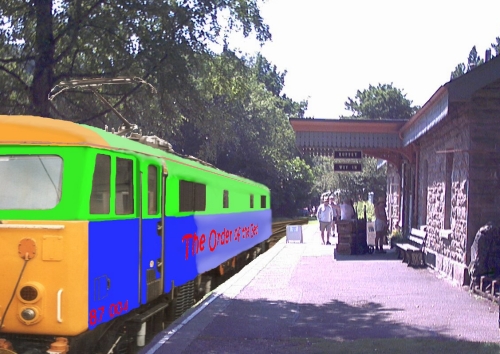
|
A modified version of an earlier image, this picture differs from the original re-hash in three respects. Firstly, track has been provided at the end of the platform; secondly, the locomotive has been repainted and re-numbered; thirdly, it has been positioned slightly differently in relation to the platform. The original engine was West Coast Class 87 electric No. 87010 in Virgin livery - the modified image shows 87004 in OB livery. The rather loud colour scheme matches the lines of the loco but would ruin the lines of the train if matched up to any coaches, which would have the green/blue dividing line about 18 inches further down the bodyshell, in order to match up with their windows. Class 87s, introduced to the West Coast Mainline in 1973, are AC electrics which draw power from overhead wires, hence the piece of equipment rising up from the roof of the loco into the tree. It is therefore unlikely that one would find itself in the Wye Valley. The locomotive in question was photographed at London Euston - its "home" London terminus and a place where there is no shortage of overhead wires - shortly before the first demise of intercity loco-hauled trains on the WCML in 2005. |
|
|
|
|
Llandogo Halt (2008)
|
Llandogo Halt actually last saw a passenger train in the snow of January 1959. The halt platform was on a curve and on the other side of the track. This view looks north as a Class 150/1 Sprinter unit prepares to depart for Monmouth The train itself was actually pictured at Penryn station in Cornwall. It has the same number as the one shown at Tidenham - 150121 - because it is the same train. Penryn is on the Truro-Falmouth branch; the 150 was actually bound for Falmouth. Both halves of this picture can be found elsewhere on the website; Llandogo Halt is seen about halfway down this page and Penryn station can be found just over halfway down this one. You can therefore illegally copy all three pictures and try to work out which bits came from where. |
|
|
|
|
Whitebrook Halt (2004) %20JPG.jpg)
|
This photo shows our first remodelling effort, with Great Western Railway Class 6400 pannier tank No. 6412 sitting at the end of the line at Whitebrook. Suitably faded out and blown up, the image formed the background picture for the main history page of the Wye Valley Railway. It has now been demoted to sidebar status, but remains a definitive image. There never has been a bufferstop at Whitebrook and, as it is a singularly illogical spot to end a railway, there probably never will be one located where the one in the picture is. Being a background image, the quality never had to be all that great (the ideal image size is actually 275x231 pixels and it's best not to look too closely at the track gauge) and it is here purely for general academic interest. 6412 has some historic connections with the Wye Valley - it worked the last train along the branch along with now-scrapped classmate 6439 - but has not been back since it was withdrawn. After working successfully on the West Somerset Railway for several years it was found to be too small for regular use and began to go on tour to other railways. It was actually photographed at Toddington station on the Gloucestershire Warwickshire Railway. The railway is also now home to Monmouth Troy station building, although sadly we didn't manage to photograph the two together. Coincidentally, the Class 87s seen at Tintern and Tidenham are currently being overhauled for export at Long Marston, 30 miles further up the former Great Western line. |
|
|
|
|
Penallt Viaduct (2009)
|
The attractive location of Penallt Viaduct is the setting for a Great Western Small Prairie tank engine clanking across the Wye light engine on its way to Monmouth. "Prairie" is the technical word (originated in the USA and adopted as a nickname here) for a locomotive with two little wheels at the front, six big wheels in the middle and two little wheels at the back, otherwise known as a 2-6-2. This nicely balanced design works very well whichever direction the locomotive is travelling in, so is useful for GWR tank engines. They should not be confused with a small area of wide, sweeping, grass-covered plain in the centre of the North American continent. The Prairie designs, of which there were several, evolved between 1900 and 1950 into a variety of locomotive types for heavier branch work and lightweight mainline work. Nearly 20 examples of the various varieties exist today in preservation, with notable examples including the last British steam locomotive to be saved for preservation and one which has spent the last couple of years pootling around Poland. They used to find their way onto the Wye Valley branch in the days when it had more freight traffic on it than a pannier tank could handle. This example was photographed, rather more recently, at Bodmin Parkway while running around its train. Penallt Viaduct survives in comparatively good condition, apart from some trees which have taken to calling it home. Five spans, originally painted black, carry the railway across the river to Redbrook. Most of the black paint has long since disappeared and the structure is now a tatty rust red, but still appears to be structurally sound. |
|
|
|
|
Coleford Branch (2006)
|
This image is set on the Coleford Branch rather than the Wye Valley Railway. It shows Standard Class 2MT No. 78019, currently based on the Great Central Railway, descending the hillside between Redbrook and Coleford with a rake of goods vans. In reality, this section of the Coleford Branch closed in 1917 and the loco was built around 45 years later. The Standard Class steam locomotives consisted of 999 locomotives built to easy-to-maintain designs with several common parts across the entire fleet. They are easily recognisable by their large cylinders and high running boards. No Standards survived more than 17 years in traffic - the first were introduced in 1950 and only one survived into 1968. The shortest-lived examples managed less than 5 years before scrapping. Had they served their projected lifespan, the last examples would have been withdrawn in the 1990s - how times change. The background image was taken in late afternoon in November while the locomotive was photographed at Rothley station one morning some six months previously. Therefore the lighting isn't quite right for this combination. The ballast doesn't merge into the landscape awfully well and the train is probably too small in relation to the trees. However, it makes a good background picture. |
|
|
|
|
Wyesham Halt (2009) 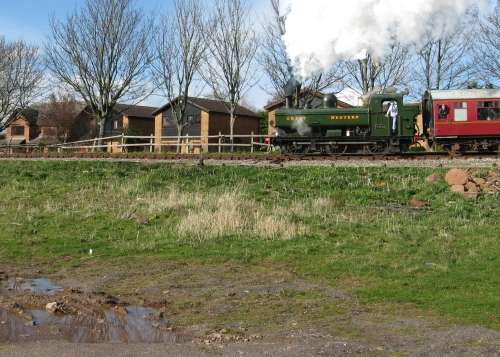
|
Wyesham Junction was the point where the Coleford Branch and the Wye Valley Railway merged for the final descent into Monmouth. After the Coleford Branch closed in 1917, the boarded up signal box remained for some years before formal abolition (i.e. it was now officially not allowed to have two trains between Monmouth and Redbrook rather than just how it worked out in practice) and demolition in the 1920s. Wyesham fell off the map for the next few years before a halt opened there in 1931. This of course closed in 1959 and once again the spot is completely irrelevant to current railway operations. It was never visited by the standard Great Western 5700 pannier tank fleet, one of which is shown here, as the Wye Valley Railway was deemed to be unsuited to them and instead only got the lightweight 6400 variety. 6400 pannier tanks have the tank slightly higher up than their 5700 cousins so the tank top is smooth across the top of the boiler. This difference, almost indistinguishable unless the two varieties are standing side by side, is one of only two immediately visible differences between them, the other being that the four-digit numbers on 6400 tanks all begin with "64". Wyesham was photographed in late March 2008 with the sun behind the camera in mid-afternoon. The pannier tank was photographed at Bodmin Parkway in mid-March 2009 with the sun behind the camera in mid-afternoon. This is very helpful for getting the two images to match nicely. The train is pulling away from the re-sited preserved halt on its way into Monmouth Troy, with a tumble-down fence and new housing estate in the background. |
|
|
|
|
Monmouth Viaduct (2010)
|
The last river crossing between Chepstow and Monmouth was at Monmouth Viaduct. A fine and lengthy structure, it made up most of the journey between the two points and opened in 1863. From Wyesham, the line descended at 1 in 66 over the Redbrook Road and then ran down an approach embankment, which led onto three stone arches. These were followed by an impressive lattice-girder spanning the Wye in one go, after which the railway passed over the floodplain on a further 20 arches of steadily decreasing height. This was then followed by a final few yards of embankment before trains twitched to the right onto the line from Ross and entered Troy station. Once the line had closed the viaduct seemed to have few uses open to it and the girder will have been getting on a bit, so the valuable steel was removed and the stonework left to decay. Nowadays the structure presents a certain image of being an affair which will fall over if anyone shouts at it too loudly. This picture shows it with most of the ivy which now covers it removed, the stonework repointed and the girder replaced. Although there used to be a few lattice-girder viaducts around they are now somewhat rare - for example, three were built by the Barry Railway in the South Welsh Valleys and all three have now been demolished to varying degrees of permanence (ranging from "a couple of piers and an abutment still standing" to "Are you sure Penyrheol Viaduct was here?"). The Severn and Wye built one at Lydbrook in 1875 but British Rail demolished it 90 years later. Consequently the girder has had to be drawn on, with some degree of success. The locomotive is the third Class 87 (in the fourth Class 87 picture) to be featured on this page. No. 87027, formerly Wolf of Badenoch, rather damaged its career prospects when it wrote off a Pacer unit in 1999 and, although repaired, was soon given the boot when withdrawal of its fleet from top link West Coast Mainline services began. It left traffic in 2004 and then did a tour of various depots around the country, all of which cheerily relieved it of parts. It won't appear here in reality since in November 2010 it became the first of the 87s featured on this page to be reduced to a small pile of scrap metal - much to the disappointment of the Founder, who had something of a fondness for the old thing (but, unfortunately, nowhere to put it). Class 87 pedants may note that it has been flipped. Day-to-day trains would be longer and in rather better external condition. |
|
|
|
|
Monmouth Troy (2010)
|
Troy station traditionally looked a little more impressive than this, with a series of medium-sized buildings, a decent station canopy and a footbridge. But beggars can't be choosers and if the railway couldn't afford to rebuild the old station (or couldn't get planning permission) then something on a smaller scale would be required. Boscarne Junction, at the west end of the Bodmin and Wenford Railway, makes a nice little model for such a station. It has a building which is simple but reflects the history of the line. The lights and benches again make it look vaguely historic. The station is 14 years old and is settling into its surroundings nicely. It is based on Southern Railway designs rather than Great Western ones, but the basic concrete platform would be common to both. The Mark 1 coach at right would only be wheeled out on the WVR for peak steam services which probably wouldn't make a habit of running this far north; since the Bodmin and Wenford is a heritage line such vehicles are common there. Boscarne was photographed in mid-March on a slightly grey day; Monmouth Troy was photographed in early January on a very grey and rather cold day. Happily the photos go together quite well. The crowds would hopefully be a routine feature. |
|
|
|
|
Monmouth Tunnel (2006)
|
The last picture in this series, perhaps inevitably, shows another 87. The doyen of the fleet, once known as Royal Scot, is one of nine Class 87s due to be spared the fate of export to Bulgaria. Instead, it is one of three which is preserved - in this case by the National Railway Museum, where it can be seen on display. It is in full working order, but lacks some modern safety equipment and is an electric, and so will probably never run again. This fine example of the outwardly unexciting breed was photographed at a Crewe Works open day in June 2003, when Virgin West Coast was hoping to be rid of the fleet in around a year. In the event it resigned from service in February 2005 when it blew its transformer. The expensive process of repairing the engine for further service was deemed to be pointless when the six remaining 87s had four months left in traffic, and so it was repaired in September 2005, after another Crewe Works open day, to allow it to run under its own power from London to York for static preservation. The picture is set at Monmouth Troy, showing the tunnel at the western end of the station. It is currently bricked up and covered in ivy, but opening it up was not too much of a challenge. Tintern Tunnel and Tidenham Tunnel were then both rather too overgrown for similar treatment, but Tintern Tunnel has now been suitably treated. |
| Home | Wye Valley Jcn to Netherhope | Tidenham Tunnel | Tintern Quarry to Tintern | Tintern Station | Brockweir to St Briavels | St Briavels to Redbrook | Wyesham to Monmouth | Signalling | Rolling stock | The Journey |
|
|
|